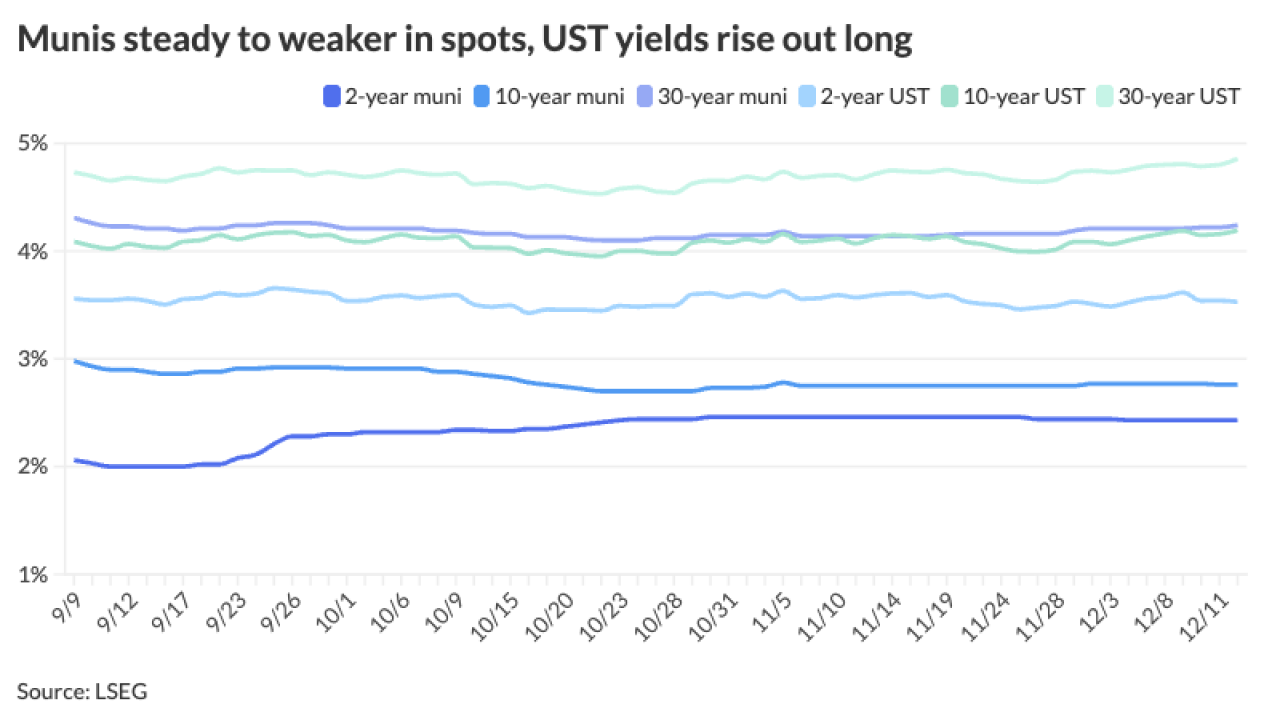
As issuers contended with various concerns throughout the first half of the year, such as possible changes to or elimination of the tax exemption, threats to funding of private universities and volatile market conditions, they flocked to the capital market to get ahead of these issues, leading to supply coming at the fastest pace on record.
Issuance during the first half of the year totaled $281.807 billion, up 14.7% year-over-year from 2024.
Issuance this year has been "relentless," with the constant onslaught beginning at the start of the year, while historically the "new-issue machine" takes a bit of time to get rolling, said Scott Diamond, co-head of AM Municipal Fixed Income at Goldman Sachs.
However, this year was different, as the momentum from 2024 carried over into the start of 2025, and it's been "impressive" ever since, he said.
The market saw elevated issuance, with an average of $10 billion to $12 billion of supply per week, up from several years ago when the average was $6 billion to $8 billion, according to Diamond.
There are even weeks that surpass the average, with issuance surging to nearly $20 billion during two separate weeks in June, putting each among the largest in volume on record.
Not every week, though, boasted robust supply, as several weeks in April saw very little.
During April, the massive tariff-induced volatility led many deals to be postponed or moved to the day-to-day calendar.
However, even that month was able to eke out positive gains because massive selling didn't occur, Diamond said.
"The retail buyer base, who owned the vast majority of our asset class, were not looking for the exits," he said.
Additionally, the market is in a higher interest rate environment now, "so you're back to where you're clipping a good 30 to 40 basis points of income on a monthly basis," Diamond said. "That buys you a little bit of a cushion to protect you if there's a little bit of a downdraft."
Part of the record influx of issuance came from issuers frontloading and accelerating deals ahead of the potential market concerns.
"There were a lot of headlines and a lot of discussion about the [tax] exemption being at risk," said Pat Luby, head of municipal strategy at CreditSights. "But here we are, and year-to-date, volume is ahead of last year's record."
While concerns arise about the possible elimination of the tax exemption every time a president is elected, the likelihood of it being repealed was slightly increased this time around. What was more likely was that parts of the tax exemption were targeted, such as private-activity bonds and issuers, such as airports, hospitals and private universities.
Now, those risks seem to have evaporated as the exemptions were untouched in the final version of the massive tax and spending bill, Luby said.
Additionally, the education sector has seen an influx of deals from prestigious universities, which came to market amid the Trump administration's funding freezes and slashed research budgets.
The sector saw $85.339 billion of issuance in the first half of the year, up 31.6%, and the growth is faster than the broad market's borrowing.
Furthermore, the market has been very volatile this year, so whenever market conditions are favorable, issuers are more likely to "price a deal as soon as they think they have a sense of positive reception from the market," Diamond said.
"So issuers may be saying, we're going to accelerate and price it today just to get it done and out of the way," he said.
Tax-exempt issuance rose 16.4% to $252.179 billion in 4,221 issues from $216.584 billion in 3,791 issues a year ago. Taxable issuance ticked up 1.8% to $18.614 billion in 483 issues from $18.292 billion in 473 issues in 2024. AMT issuance was $11.014 billion, up 2.6% from $10.732 billion in 2024.
New-money issuance rose 25% to $209.549 billion from $167.681 billion, while refundings fell 29.6% to $30.527 billion from $43.343 billion.
Revenue bond issuance increased 8.7% to $177.494 billion from $163.295 billion in 1H 2024, and general obligation bond sales rose 26.7% to $104.313 billion from $82.314 billion in 2024.
Negotiated deal volume was up 14.8% to $224.271 billion from $195.409 billion a year prior. Competitive sales rose 29.2% to $53.579 billion from $41.463 billion in 2024.
Bank-qualified issuance increased 6.9% to $4.392 billion in 1,072 deals from $4.108 billion in 1,071 deals a year prior.
California claimed the top spot year-to-date among states.
Issuers in the Golden State accounted for $45.64 billion, up 26.1% year-over-year. Texas was second with $30.588 billion, down 7.4%. New York was third with $30.093 billion, up 6.6%, followed by Florida in fourth with $10.156 billion, down 18.5%, and Pennsylvania in fifth with $9.831 billion, an 88.7% increase from 2024.
Rounding out the top 10: Massachusetts with $8.38 billion, down 16.4%; Michigan with $7.776 billion, up 53.3%; Colorado with $7.633 billion, up 36.8%; Illinois with $6.942 billion, up 10.3%; and Wisconsin with $6.891 billion, up 26.3%.





